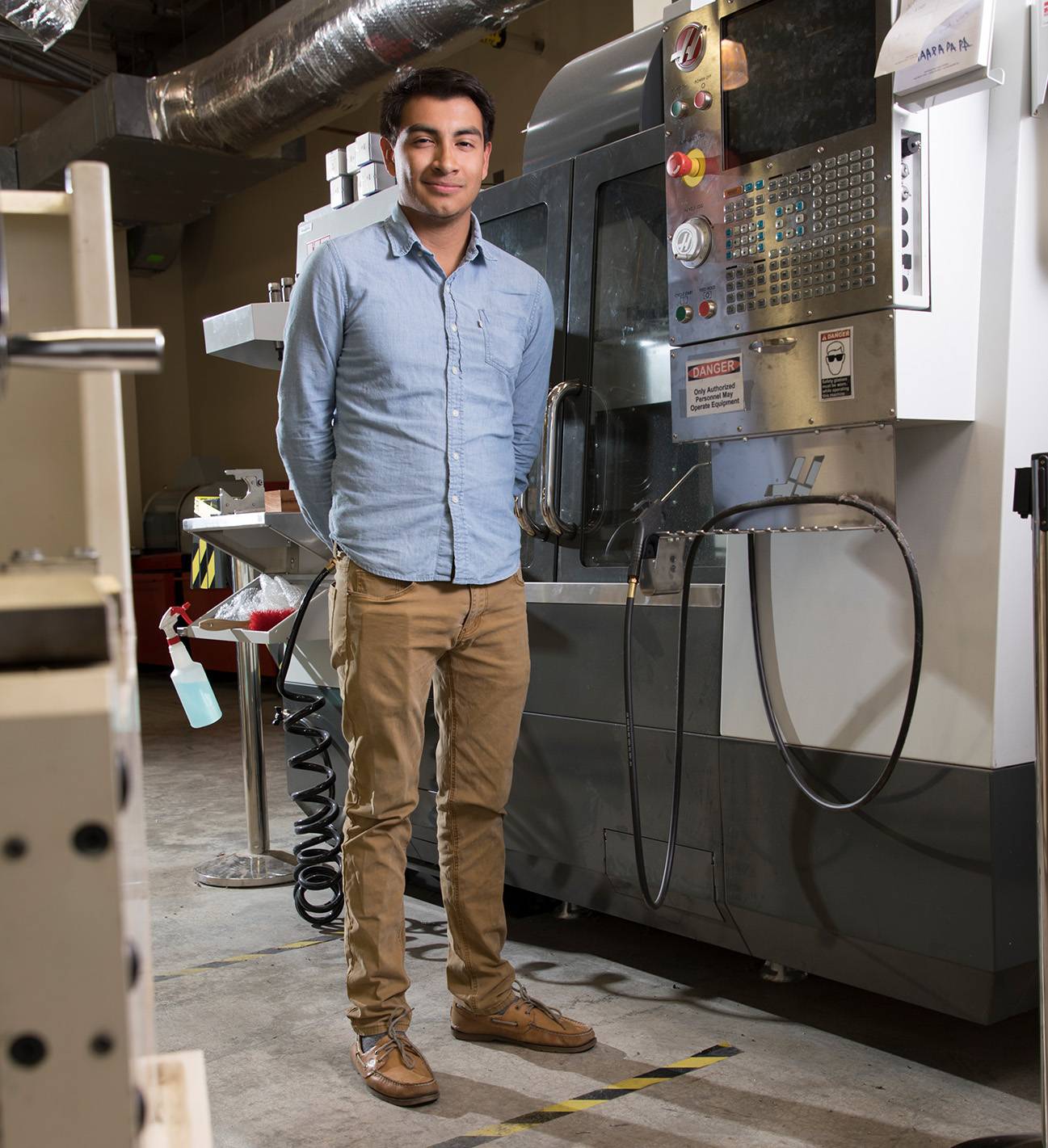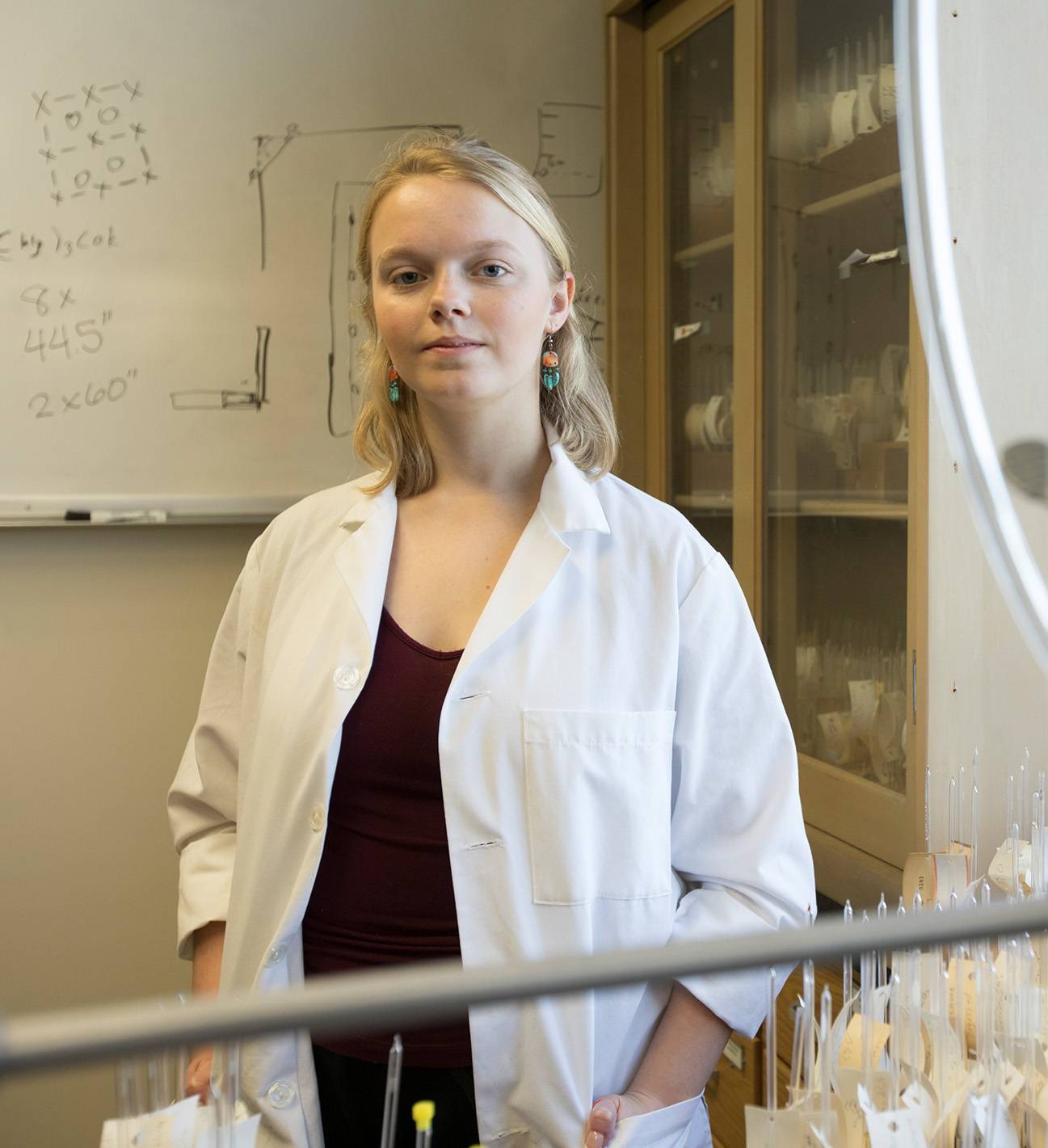
Meeting the demand in science and technology
by Anastasia Cisneros-Lunsford
H-LSAMP program aims to graduate minority students with STEM degrees
The Houston-Louis Stokes Alliance for Minority Participation Scholars Program (H-LSAMP) at Texas State University collects talent and nurtures drive at full throttle to fuel in-demand and skilled job candidates in science, technology, engineering, and mathematics.
Eunice Solis says H-LSAMP provided her with many opportunities to network with different companies and explore various career paths. “The program prepared me professionally in ways that I could never have learned in the classroom,” she says.
For three years, she shared the same passion for excellence with other H-LSAMP students who were not satisfied with being an average candidate in the job market. “I am proud to have been in a program that fostered this drive and collected this talent all in one place so that we could grow together,” says Solis, who graduated in 2017 with a bachelor of science in technology degree with a specialization in mechanical systems. The Corsicana native now lives in New Mexico where she is a research scientist with the foundry and solidification science team at Sigma Labs, a manufacturing science division at Los Alamos National Laboratory.
H-LSAMP, supported by the National Science Foundation, has become a model alliance. The program was established in 1999 by Dr. Stan Israel, then dean of the College of Science, in partnership with other institutions in the Houston area to increase the quality and quantity of underrepresented students graduating with degrees in science, technology, engineering, and mathematics (STEM).
Strong role models
Susan Romanella, H-LSAMP program director at Texas State, says each alliance across the country runs their program differently, based on the needs of each university, but share many common elements. “This program enriches the academic life of our students,” Romanella says. “We get students involved in undergraduate research, internships, and co-ops. They tutor in the Collaborative Learning Center. The students are mentored throughout the years in the program and they receive significant financial stipends. We send them to professional and scientific conferences to present their research and for their own professional and personal development.”

Romanella says there also is another purpose for student involvement in the program. “They are a community of strong role models for minorities and underrepresented students in STEM, and this is so important in supporting and encouraging other students.”
H-LSAMP scholars are highly motivated individuals, say Dr. David Drew and Dr. Martin Bonsangue, the two professors who evaluate the Texas State program for the National Science Foundation.
“Texas State has been ahead of other colleges and universities by institutionalizing the program by providing physical space and university funds to make it an ongoing resource for future students,” says Drew, professor of education at Claremont Graduate University. “There are talented students everywhere but opportunity is not distributed everywhere. This program can have a catalytic effect on a student. There are many students who are underrepresented in STEM — women, students of color, students from poverty. H-LSAMP allows them to flourish and provides the resources and strategies for them to flourish.”
Graduating with honors
Investing in the program also means investing in the outcomes, says Bonsangue, professor of mathematics at California State University, Fullerton. “H-LSAMP is about Texas State students like Andrew Alvarez and Laura Godinez,” he says. “It’s about the individuals. These students are not just first-generation students, they are graduating with honors; they’re graduating summa and magna. It’s phenomenal the sorts of activities they’ve been involved with. Research experience as undergraduates and internships — these are the norm.”
Alvarez, a senior industrial engineering major, and Godinez, a senior computer science major, had the opportunity to travel to the East Coast for conferences. Romanella says when Alvarez returned from the Dow- MIT Access Program at the Massachusetts Institute of Technology, a conference about the benefits of a graduate education in chemistry, chemical engineering, and materials science, he came back “walking 10 feet off the ground.”
Alvarez admits that he felt intimidated when he first joined H-LSAMP. “Students were doing far more than I was,” he says. “My immediate interest in graduate school was not sparked until I attended MIT. I was really amazed at what could be more than just a bachelor’s degree, so my goal now is to pursue a Ph.D.”
For Laura Godinez, H-LSAMP is a blessing. She attended SheHacks Boston, the Grace Hopper Conference for Women in Computing. Godinez was also part of a fellowship program called Code2040, a career accelerator program that works with African-American and Latinx computer science students. “It has been a real eye-opener to be able to see people like me in positions in the technology industry,” says Godinez, who was a software developer intern this past summer at PagerDuty, a San Francisco-based company. “H-LSAMP has helped me develop a better sense of what I want to do once I graduate college.”
For senior Carlos Corona, a chemistry major, H-LSAMP also has provided a path to the future. “I have a clear vision of what I want and that helps me map out how to get it and ways to develop myself and develop others,” he says.

Corona says seeking success means extending his experience beyond H-LSAMP, taking leadership roles at Texas State including student executive of operations in the Partnership for Research and Education in Materials program; STEM Student Advisory Board member; Chemistry/Biochemistry Advisory Council member; and past vice president for the Society for the Advancement of Chicanos and Native Americans in Science.
Corona seeks guidance from his mentor, Dr. Michael Burns, senior lecturer in the Department of Communication Studies. He believes communication is the bridge between science and technology. “You can have a great idea or a great product but if you can’t communicate it effectively to investors or the public, it becomes an idea wasted,” Corona says.
Burns says H-LSAMP scholars such as Corona are gaining an invaluable experience when they are matched with a mentor. “These students are gaining confidence and insight that many students will never receive because they do not seek out mentors to help them through college,” he says. “All of the students who participate have stories about how they got involved in different projects, research, and activities because of their mentor."
Associate Professor Dr. Clara Novoa gave H-LSAMP senior Javier Ortiz basic training in 3D printing. “Then, I let him refine this knowledge by using the 3D printers to help students develop their capstone projects,” she explains. Ortiz produced working parts for nearly seven different needs including a case for an olfactory system and the shell of a solar-powered buoy to measure water quality, both for NASA, and parts for robots. This fall, the industrial engineering major will be getting cooperative education work experience at Infineon Technologies in Munich, Germany.
Field testing is H-LSAMP scholar Ananda Diener’s niche. She graduated in May with a bachelor of science in chemistry. Diener also minored in biology and received several prestigious awards including the Texas State University System Regents’ Scholar award. “I’ve done Stream Team testing on the San Marcos River,” Diener says. “I like being in the field, in nature gathering samples. I like environmental chemistry, and I also like management positions.”
The potential for jobs is phenomenal, Romanella says, adding that H-LSAMP scholars are working at top global companies such as Boeing, NASA, IBM, General Motors, John Deere, Samsung, and Intel. Elisa DeFord, career advisor for the College of Science and Engineering,helps students find opportunities to develop their marketable skills and connects them with employers. She applauds Romanella’s intensity to push her students to succeed. “She is a great advocate for Career Services and regularly encourages the scholars to attend Career Services events — and they listen to her,” DeFord says.
Romanella encourages H-LSAMP scholars to constantly set goals for themselves. Alvarez wanted to do research out of state. This summer, he was one of 60 students selected for the Research Intensive Summer Experience program at Rutgers University. Research topics ranged from graphene composites and the application of computational materials concepts to advanced catalysts for use in the pharmaceutical and petroleum industries. For his final year at Texas State, Alvarez is hoping to land a six-month co-op work position.
“That is my goal, to go to Munich, to work there for six months and say I have this experience,” he says. “No one is telling me to do this. I want it. It’s a new challenge on the horizon.” Alvarez credits H-LSAMP for developing him into who he is today. “I don’t believe I had this initiative two years ago. The drive I have now has definitely been molded by members and the director of H-LSAMP,” he says. “They have taught me not to just shoot for the next job; you want to shoot for the best position at that job.
“You want to shoot for the CEO position. You want to get to the mountaintop. When you get to the mountaintop, you want to make a ladder to go even further. That’s what H-LSAMP teaches me, to continue to strive for something greater.” ✪